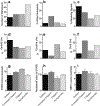The chippers, the quitters, and the highly symptomatic: A 12-month longitudinal study of DSM-5 opioid- and cocaine-use problems in a community sample
- PMID: 31108264
- PMCID: PMC6587183
- DOI: 10.1016/j.addbeh.2019.04.030
The chippers, the quitters, and the highly symptomatic: A 12-month longitudinal study of DSM-5 opioid- and cocaine-use problems in a community sample
Abstract
Background: Individual trajectories of drug use and drug-related problems are highly heterogeneous. There is no standard taxonomy of these trajectories, but one could be developed by defining natural categories based on changes in symptoms of substance-use disorders over time.
Methods: Our study was conducted in a community sample in Baltimore, Maryland. At baseline, all participants were using opioids and/or cocaine, but none were in treatment. Drug use and symptomatology were assessed again at 12 months (N = 115).
Results: We defined Quitters as participants who had not used for at least 30 days at follow-up (17%). For the remaining participants, we performed longitudinal cluster analysis on DSM symptom-counts, identifying three trajectory clusters: newly or persistently Symptomatic (40%) participants, Chippers (21.5%) with few symptoms, and Converted Chippers (21.5%) with improved symptom counts. Logistic regression showed that profiles of Quitters did not resemble Chippers, but instead resembled Symptomatic participants, having high probability of disorderly home neighborhood, nonwhite race, and negative mood. Quitters tended to have two protective factors: initiating opioid-agonist treatment during the study (reffect = 0.25, CL95 0.02-0.48) and lack of polydrug use (reffect = 0.25, CL95 0.004-0.49). Converted Chippers tended to be white, with orderly home neighborhoods and less negative mood (reffects 0.24 to 0.31, CL95 0.01-0.54).
Conclusions: Changes in DSM symptomology provided a meaningful measure of individual trajectories. Quitters shared psychosocial characteristics with Symptomatic participants, but not with participants who continued to use with few symptoms. This suggests that Quitters abstained out of necessity, not because their problems were less severe.
Trial registration: ClinicalTrials.gov NCT01571752.
Keywords: Cocaine; DSM-5; Opioid; Substance use disorder; Trajectory.
Copyright © 2019 Elsevier Ltd. All rights reserved.
Conflict of interest statement
The authors report no conflicts of interest.
Figures




Similar articles
-
Health Outcomes by Neighborhood (HON): Effects of Neighborhood, Social Instability, and Health Factors on 12-Month Trajectories of Substance-Use Disorder Symptoms.Subst Use Misuse. 2023;58(12):1460-1472. doi: 10.1080/10826084.2023.2223258. Epub 2023 Jun 28. Subst Use Misuse. 2023. PMID: 37380598 Free PMC article.
-
Beyond abstinence and relapse II: momentary relationships between stress, craving, and lapse within clusters of patients with similar patterns of drug use.Psychopharmacology (Berl). 2021 Jun;238(6):1513-1529. doi: 10.1007/s00213-021-05782-2. Epub 2021 Feb 8. Psychopharmacology (Berl). 2021. PMID: 33558983 Free PMC article.
-
Baseline risk factors for drug use among African-American patients during first-month induction/stabilization on methadone.J Subst Abuse Treat. 2017 Jul;78:15-21. doi: 10.1016/j.jsat.2017.04.007. Epub 2017 Apr 14. J Subst Abuse Treat. 2017. PMID: 28554598
-
Folic acid supplementation and malaria susceptibility and severity among people taking antifolate antimalarial drugs in endemic areas.Cochrane Database Syst Rev. 2022 Feb 1;2(2022):CD014217. doi: 10.1002/14651858.CD014217. Cochrane Database Syst Rev. 2022. PMID: 36321557 Free PMC article.
-
Progress in agonist therapy for substance use disorders: Lessons learned from methadone and buprenorphine.Neuropharmacology. 2019 Nov 1;158:107609. doi: 10.1016/j.neuropharm.2019.04.015. Epub 2019 Apr 19. Neuropharmacology. 2019. PMID: 31009632 Free PMC article. Review.
Cited by
-
Affect-laden risk profiles derived from two days of EMA predict substance use and quality of life three- and six-months after SUD treatment.J Subst Use Addict Treat. 2025 Mar;170:209613. doi: 10.1016/j.josat.2024.209613. Epub 2024 Dec 21. J Subst Use Addict Treat. 2025. PMID: 39716517 No abstract available.
-
Time-varying effect modeling with intensive longitudinal data: Examining dynamic links among craving, affect, self-efficacy and substance use during addiction recovery.Addiction. 2023 Nov;118(11):2220-2232. doi: 10.1111/add.16284. Epub 2023 Jul 7. Addiction. 2023. PMID: 37416972 Free PMC article.
-
Prediction of stress and drug craving ninety minutes in the future with passively collected GPS data.NPJ Digit Med. 2020 Mar 4;3:26. doi: 10.1038/s41746-020-0234-6. eCollection 2020. NPJ Digit Med. 2020. PMID: 32195362 Free PMC article.
-
Exploring the Relationship Between Substance Use and Allostatic Load in a Treatment/Research Cohort and in a US Probability Sample (NHANES 2009-2016).Front Psychiatry. 2021 Aug 2;12:630195. doi: 10.3389/fpsyt.2021.630195. eCollection 2021. Front Psychiatry. 2021. PMID: 34408672 Free PMC article.
-
Beyond abstinence and relapse: cluster analysis of drug-use patterns during treatment as an outcome measure for clinical trials.Psychopharmacology (Berl). 2020 Nov;237(11):3369-3381. doi: 10.1007/s00213-020-05618-5. Epub 2020 Sep 29. Psychopharmacology (Berl). 2020. PMID: 32990768 Free PMC article.
References
-
- American Psychiatric Association. (1994). Diagnostic and Statistical Manual of Mental Disorders, Fourth Edition (DSM-IV) Washington, DC: Anerican Psychiatric Association.
-
- American Psychiatric Association. (2013). Diagnostic and Statistical Manual of Mental Disorders, Fifth Edition (DSM-5). Washington, DC: American Psychiatric Association.
-
- Brunton-Smith I, Sturgis P, & Leckie G (2018). How collective is collective efficacy? The importance of consensus in judgments about community cohesion and willingness to intervene. Criminology, 56(3), 608–637.
-
- Carroll KM, Kiluk BD, Nich C, DeVito EE, Decker S, LaPaglia D, … Ball SA (2014). Toward empirical identification of a clinically meaningful indicator of treatment outcome: Features of candidate indicators and evaluation of sensitivity to treatment effects and relationship to one year follow up cocaine use outcomes. Drug and Alcohol Dependence, 137, 3–19. - PMC - PubMed
Publication types
MeSH terms
Associated data
Grants and funding
LinkOut - more resources
Full Text Sources
Medical

